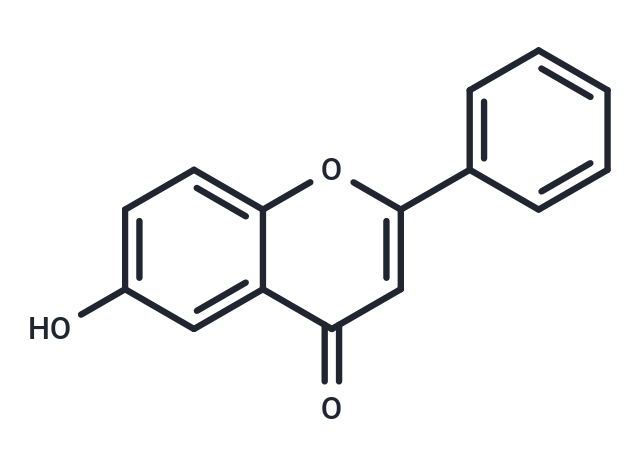Shopping Cart
- Remove All
 Your shopping cart is currently empty
Your shopping cart is currently empty

6-Hydroxyflavone (6-HF) is a noncompetitive inhibitors of cytochrome P450 2C9. It is a flavone, a type of chemical compound. It is reported in leaves of Barleria prionitis Linn. (a common Acanthaceae from India). 6-Hydroxyflavone may have a potential as a therapeutic drug capable for the treatment of anxiety-like disorders.

| Pack Size | Price | Availability | Quantity |
|---|---|---|---|
| 100 mg | $39 | In Stock | |
| 500 mg | $91 | In Stock | |
| 1 mL x 10 mM (in DMSO) | $43 | In Stock |
| Description | 6-Hydroxyflavone (6-HF) is a noncompetitive inhibitors of cytochrome P450 2C9. It is a flavone, a type of chemical compound. It is reported in leaves of Barleria prionitis Linn. (a common Acanthaceae from India). 6-Hydroxyflavone may have a potential as a therapeutic drug capable for the treatment of anxiety-like disorders. |
| Kinase Assay | For Jak3 kinase assays, Fsk-treated MT-2 cells are lysed, clarified, and immunoprecipitated using Jak3 antibody. Kinase reactions are carried out at 30°C for 20 min. For PKA kinase assays, untreated MT-2 cells are lysed, and Jak3 is immunoprecipitated and bound to PAS beads. Immunoprecipitated Jak3 is washed with kinase buffer (50 mM Hepes-NaOH (pH 7.4), 10 mM MgCl2, 0.5 mM EGTA, 0.5 mM DTT, 20 μg/mL aprotinin, 10 μg/mL leupeptin, 1 μg/mL pepstatin A) and incubated with 200 μM ATP and purified protein kinase A catalytic subunit (PKAc) as indicated in the figure legends. Kinase reactions are carried out at 32 °C for 30 min followed by vigorous washing of the beads with cold kinase wash buffer. For [γ-32P]ATP radiolabeled kinase assays using recombinant Jak3, Hek293 cells are transfected with wild type (WT) Jak3 or kinase-dead Jak3 K855A using Lipofectamine 2000 according to the manufacturer's instructions. Cells are lysed and immunoprecipitated with Jak3 antibody. Jak3-bound PAS beads are washed three times in cold lysis buffer followed by kinase buffer. Kinase reactions are initiated by adding 10 μCi [γ-32P]ATP, 10 μM unlabeled ATP, and 1 μg of purified PKAc to Jak3-bound PAS bead reaction mixtures. Kinase reactions are performed at 32°C for 30 min. Jak3-bound PAS beads are washed three times in radioimmunoassay buffer (10 mM Tris-HCl, pH 7.4, 75 mM NaCl, 20 mM EDTA, 10 mM EGTA, 20 mM Na4P2O7, 50 mM NaF, 20 mM 2-glycerolphosphate, 1 mM p-nitrophenylphosphate, 0.1% Triton X-100) and one time in kinase wash buffer. The reactions are stopped by adding 2× SDS-PAGE sample buffer followed by SDS-PAGE. Coomassie stainable Jak3 bands are excised from the PVDF membrane and subjected to phosphoamino acid analysis[2]. |
| Alias | 6-HF |
| Molecular Weight | 238.24 |
| Formula | C15H10O3 |
| Cas No. | 6665-83-4 |
| Smiles | Oc1ccc2oc(cc(=O)c2c1)-c1ccccc1 |
| Relative Density. | 1.34g/cm3 |
| Storage | Powder: -20°C for 3 years | In solvent: -80°C for 1 year | Shipping with blue ice. | |||||||||||||||||||||||||
| Solubility Information | DMSO: 6.5 mg/mL (27.28 mM), Sonication is recommended. | |||||||||||||||||||||||||
Solution Preparation Table | ||||||||||||||||||||||||||
DMSO
| ||||||||||||||||||||||||||

Copyright © 2015-2025 TargetMol Chemicals Inc. All Rights Reserved.